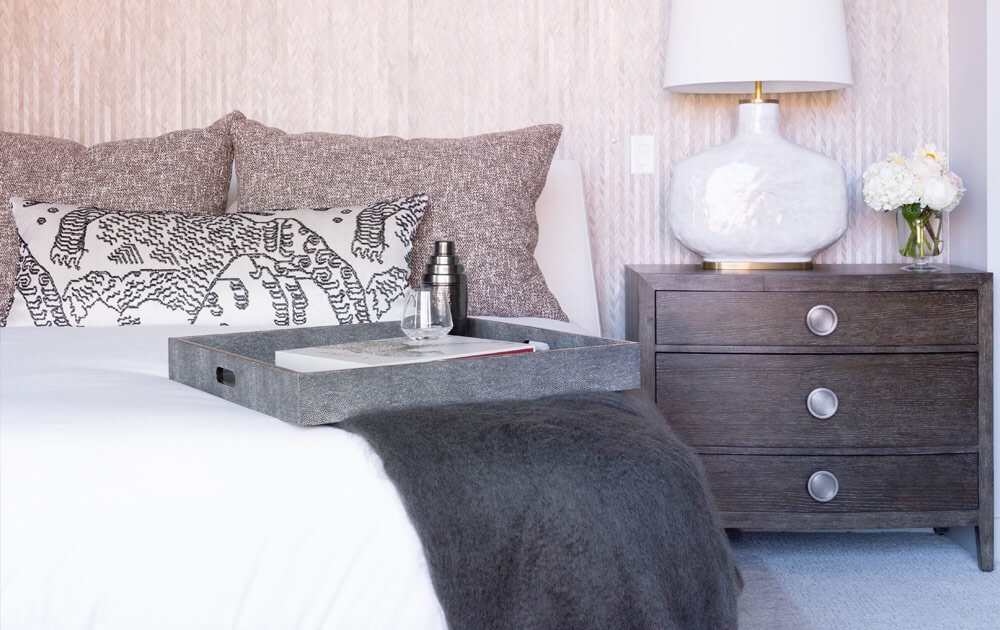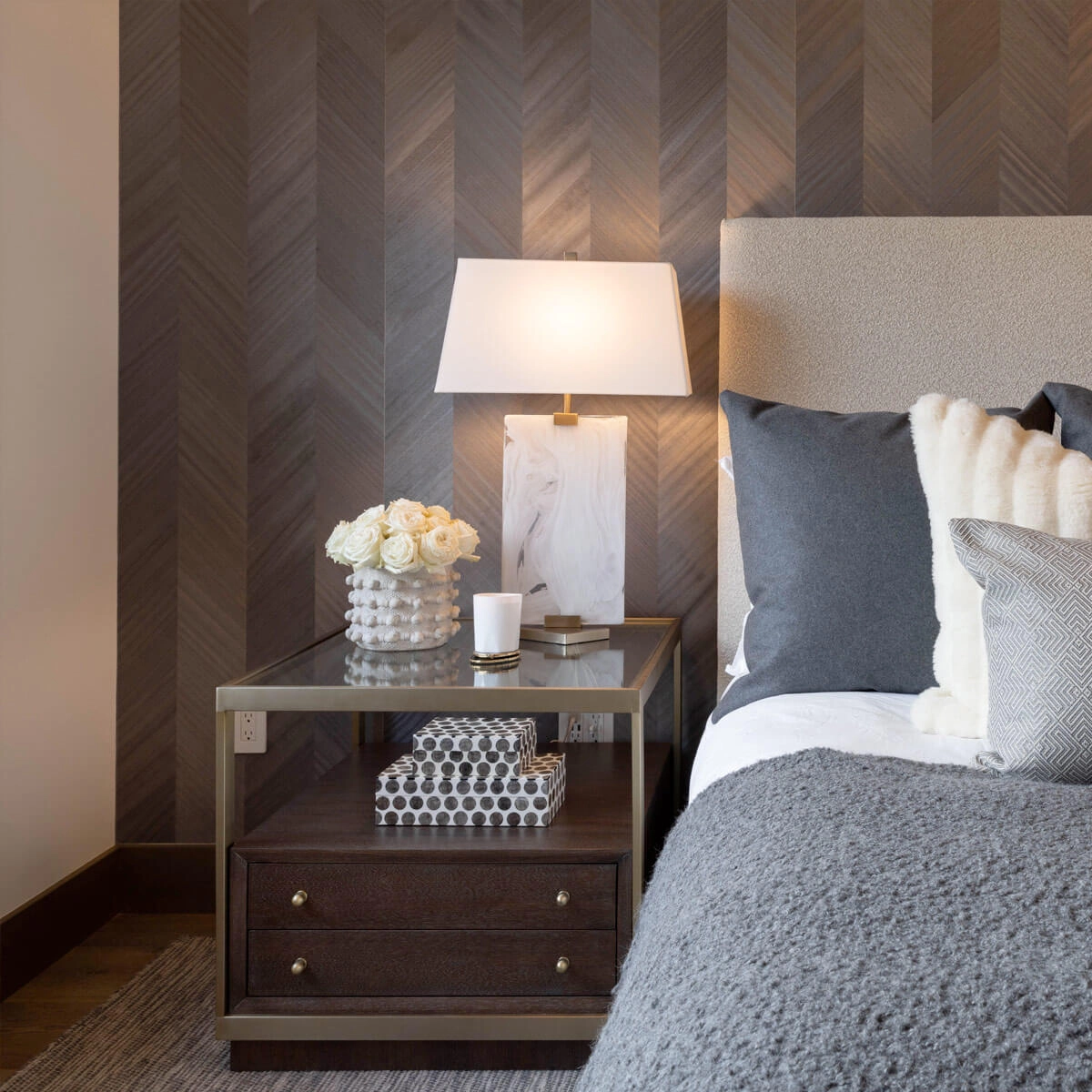1. Get the Nightstand Dimensions Right
The most important part of choosing the best nightstand is to make sure you pick one with dimensions that are proportionate to your bed frame.
“Unless you have a bed that’s very low to the ground, I always prefer my nightstand to be at least 30 inches tall to look proportional and maximize functionality,” says Heather Humphrey. “The nightstand table should have at least one or two inches on each side of the bed and wall to ensure it fits comfortably within the available space.”
Stefanie Cheng determines the proportions of her nightstand by comparing it to the height of her bed. “Your nightstand’s height should be mattress height or lower to create a sense of hierarchy,” says Cheng. “The bed should be the tallest item in the space, as tiny nightstands tend to look ridiculous next to huge beds.”
Nightstand Dimensions by Bed Size:
As a rule of thumb, the larger your bed is, the larger your nightstand should be. After all, you “don’t want tiny ‘dollhouse-sized’ nightstands flanking a King bed, especially if you have a large room and plenty of space,” says Rebecca West.
The following dimensions, provided by Molly McGinness, serve as a guideline for the nightstand size you should shop for, depending on your bed size.
- Twin Bed: According to Molly McGinness, nightstands on either side of a twin bed should measure between 20 and 24 inches wide but should be wider if you’re placing one nightstand between two twin beds.
- Queen Bed: For a queen-size bed, McGinnes advises choosing a nightstand around 30 inches wide if the room allows for one on each side. However, if you’re working with a small space, it’s worth choosing a small nightstand to ensure that there’s still room between the nightstand and the wall.
- King Bed: When choosing a nightstand for a king-size bed, McGinnes suggests two 36-inch nightstands if space allows. “I want the room to be big enough so it’s not overwhelmed with all the beds,” says McGinnes.
How Tall Should a Nightstand Be?
The height of your nightstand also depends on the height of your bed frame. For example, platform beds require shorter nightstands, while elevated beds work best with nightstands that are equivalent to the height of the mattress.
Molly McGinness agrees. “The height of your nightstand should depend on the height of your mattress and the support that the mattress sits on,” she says. “I like the height of my nightstand to be roughly the same height as the top of my mattress because you don’t want to be in bed and have to reach too high or low to grab something off the top of your nightstand.”

So, if you have a modern platform bed with just a mattress on top, the nightstand will be low, possibly between 12 and 18 inches tall. If you have a more traditional bed frame, box spring, and mattress, you’ll want the nightstand's top to match that height.
According to KD Reid, the typical nightstand is 23 to 28 inches high. “These nightstands suit conventional upholstered bed frames perfectly because the top of most mattresses is 24 inches from the ground.”
Nightstand height is typically divided into three categories: low, standard, and tall. Use these categories as a guideline when shopping for your new nightstand.
- Low: Low nightstands are usually lower than 23 inches high and pair best with modern platform beds.
- Standard: A standard nightstand is between 23 and 28 inches tall. These nightstands are perfect for the typical bed frame, as the top of most mattresses clock in at 24 inches from the ground.
- Tall: Tall nightstands are greater than 30 inches high and work best with lofted bed frames and beds that have box springs or thick mattress toppers.
How Wide Should a Nightstand Be?
While nightstand width certainly matters less than nightstand height, it’s still a factor to consider when determining the piece's proportions.
Kathy Kuo recommends considering your nightstand’s daily use while deciding how wide its surface should be. “Will you use your nightstand as a surface for just a glass of water, a book, or a few personal items, or will you also want enough space for a bedside lamp and alarm clock?” Kuo suggests asking yourself. These details will inform the amount of surface area you keep in mind while shopping.

However, the width of your nightstand also influences how your space's dimensions are perceived. While you might love the space an especially wide nightstand provides, it may not look proportional when paired with a twin bed. As Stefanie Cheng says, “Make sure to balance out the size of your bed with a nightstand that visually helps to ground your bed in the space.”
Take into account the below guidelines for nightstand width while shopping for your new piece:
- Narrow: Narrow nightstands are typically between 12 and 18 inches wide and pair best with twin beds.
- Standard: Standard-size nightstands are between 18 and 24 inches wide and are best for double and queen-size beds.
- Wide: Wide nightstands are over 30 inches wide and pair well with king or California king-size beds.
2. Consider Style and Design
When purchasing a new nightstand, consider the visual impact it will have on your modern bedroom. Heather Humphrey suggests asking yourself how much space you have to fill and what your storage needs are.
“Nightstands come in many materials and colors that will complement the space in different ways. For example, if you’re going for a glamorous vibe, a high-gloss lacquer nightstand could be a good option. If you’re going for a more rustic look, however, you might consider a more textured wooden nightstand,” says Humphrey.

Kathy Kuo likes to consider the overall look of the rest of the room before purchasing a new piece of furniture. For example, “If your bed and dresser have a French country look, it’s a nice visual throughline to match your nightstands to the existing decor in the space,” says Kuo.
3. Consider the Proportions of the Room
Next, consider your space. While dual nightstands are always ideal, it’s important to consider the size of the room to ensure adding two nightstands won’t make the space feel small and cluttered.
Heather Humphrey says that she “tries to be mindful of the size and shape of the headboard along with other furniture needs so the room doesn’t feel overcrowded… but if you’re working with a tight space, utilize built-in headboards and nightstands, as it’s a great opportunity to be creative and maximize space.”
4. Think About Function
When thinking about function, Molly McGinness considers her clients' lifestyles. “If they’re minimalists with no ‘stuff,’ an open shelf type of nightstand might work,” says McGinnes. If they have many things they like to have bedside, a drawer nightstand might be a better option.”
Rebecca West, on the other hand, prioritizes storage needs and lighting. “You don’t want to choose a large table lamp for a tiny nightstand and have no place left to set down your glasses, reading materials, and phone,” says West.

West also takes storage features into account while choosing a nightstand for her clients. “If you have a storage bed with drawers that pull out from the sides, you’ll want to make sure that the size and style of the nightstand will allow those drawers to open easily.”
Finally, consider your electronics. “You may also want to think about how many devices will be plugged in behind your nightstand,” says Rebecca West. “Choosing one with a solid back will hide those cords better than a light and leggy, or glass, nightstand.”
5. Don’t be Afraid to Mix and Match
Although there are plenty of bedroom sets on the market, don’t be afraid to mix and match your bed and nightstand. “I would never buy a matching set,” says Molly McGinness. “That would look uninspired.” Instead, McGinnes chooses to shop for beds and nightstands separately to ensure that both bring a unique level of interest to the bedroom.
For some clients, McGinnes even brings in nightstands made from different materials. “I may place a metal nightstand with a dark wood bed or a mirrored nightstand with an upholstered headboard,” says McGinnes. “It’s important to create balance when choosing your nightstand. The dimensions and visual weight may be similar, so they look balanced in the overall scheme of things.”
To achieve balance and symmetry, you don't always need the perfect match of styles. You can incorporate minimalistic pieces into a traditional bedroom to create visual appeal and practical functionality. For example, pairing a sleek, modern nightstand with classic, ornate bedroom decor can offer a unique contrast that enhances the room's character. This approach not only adds an eclectic and modern look to your space but also provides the necessary storage space for personal items, making your bedroom both stylish and functional.
Heather Mastrangeli agrees that you don't need to worry about matching your bed and nightstands. “Nightstands don’t necessarily need to match or match the bed. However, if you do match everything, it will make the space feel more formal, while mismatching can feel more informal,” adds Mastrangeli.

Kathy Kuo has tried a similar tactic. “Many people really love the look of matching nightstands on either side of the bed,” she says. “However, I've found that it can look very stylish and eye-catching to mix and match nightstands.”
Kuo says that her advice would be to mix and match nightstands with intention if you're going to do it. “Don't just throw two bedside tables together at random, but let your overall style be your guide and aim to choose two nightstands of the same style.”
When Rebecca West is mixing and matching nightstands, her key consideration is to choose two nightstands of the same width and height. However,
“if they aren’t, consider using mix-matched lamps so the top heights of the lamps are the same, or use books or decorative boxes to lift one lamp so they end up at the same height,”
says West.
In college, I wanted nothing more than a nightstand. The ability to place my glasses, evening snacks, and reading material on a nightstand before bed felt like an incredible luxury. Unfortunately for me, nightstands weren’t part of each dorm room’s standard furniture set. It makes sense that as an adult, I take particular joy out of shopping for a nightstand. But with the variety of nightstand designs available, picking the best nightstand option for your space can feel overwhelming. To help, we compiled 5 tips from design experts to help you find the perfect nightstand.














